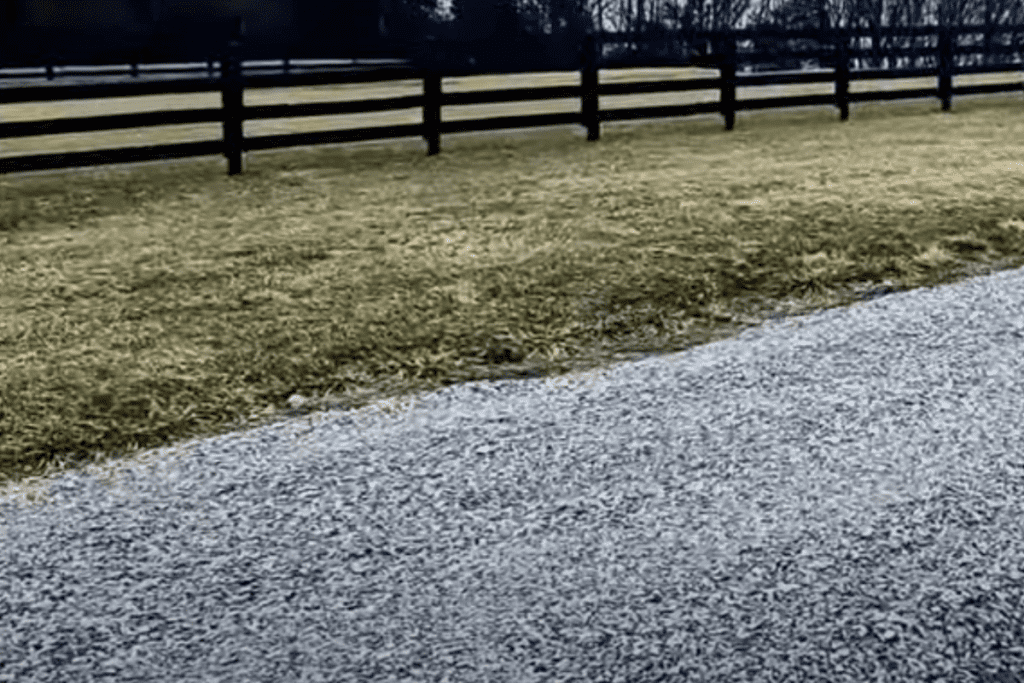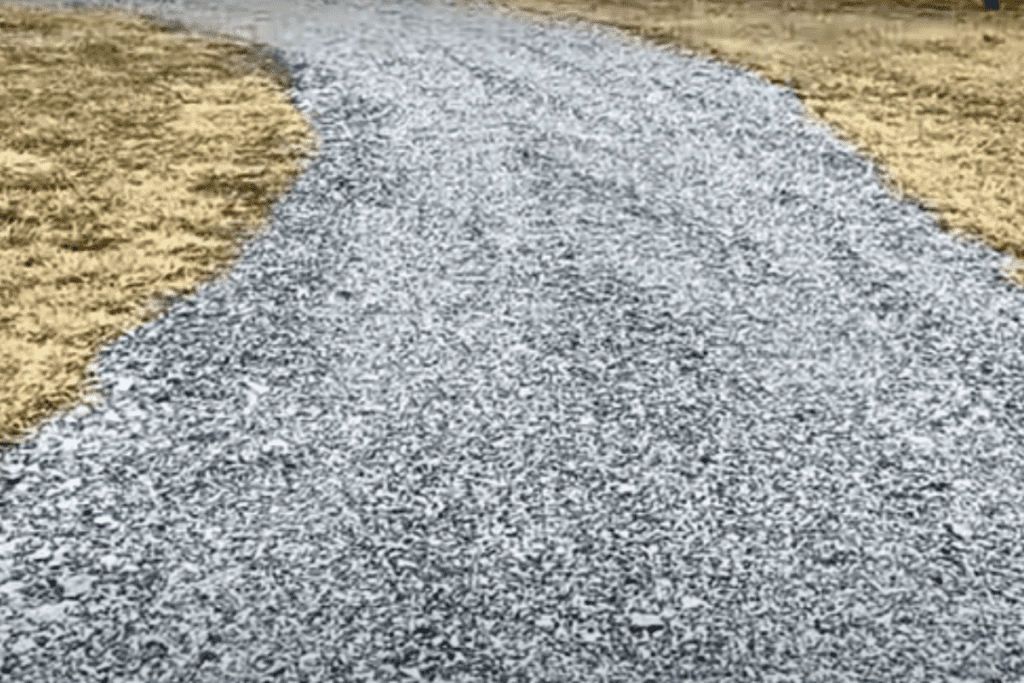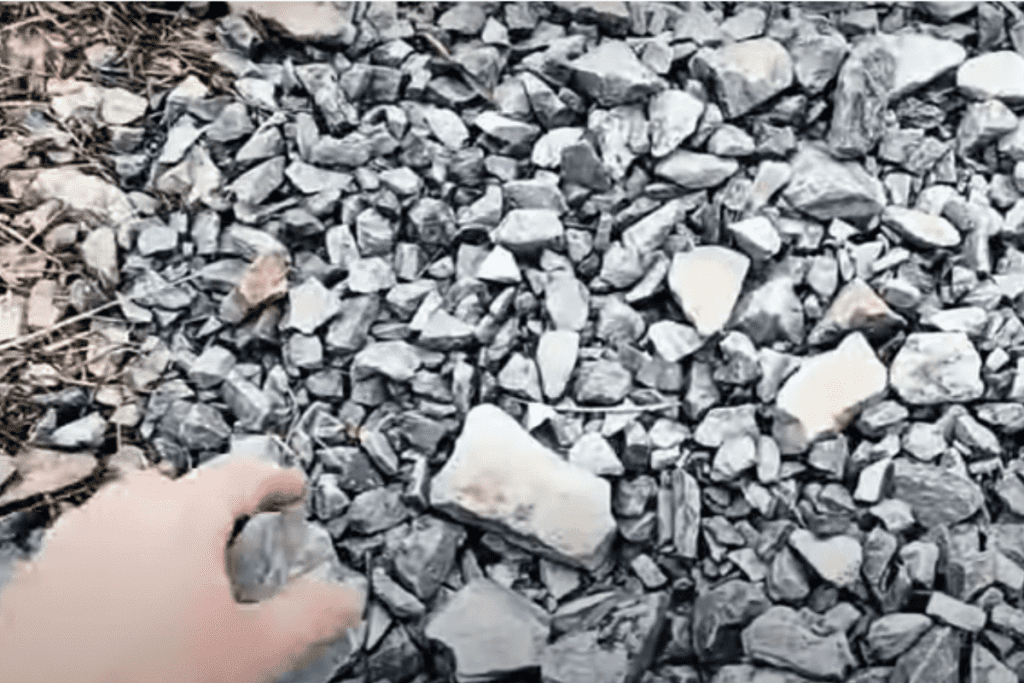A gravel driveway is more affordable than an asphalt or concrete driveway, so many homeowners choose this option.
Creating a gravel driveway over grass is a labor-intensive but straightforward process.
While it is unnecessary to remove existing grass before laying the gravel, doing so will prevent any problems later on.
Once the grass begins to die, uneven areas in the ground may appear.
These rough areas will create dips in your gravel driveway, collecting water and possibly washing away your gravel.
Leaving the grass underneath the gravel layer will make your driveway more prone to weeds, even if you use a weed barrier such as geotextile fabric.
Keep reading for a guide on making a gravel driveway over existing grass, and learn what you need to do before you get started.
Table of Contents
Materials Needed
Most of these materials are easily found at farming supply stores and garden centers.
For the gravel, you will need to contact a company for gravel delivery.
If you are able to hire a bulldozer, it will be very helpful for compacting the gravel layers.
You will need the following materials to create a gravel driveway over grass:
- Landscaping stakes (view on Amazon)
- Twine
- Work gloves
- Wheelbarrow
- Shovel
- Rake
- Hoe
- Landscape fabric (view on Amazon)
- Gravel
Before You Begin
Before laying your gravel driveway, there are several necessary steps to make the entire process go more smoothly.
You will first need to use the landscape stakes and twine to map out the desired driveway path you want to create.
Once the path is laid out, you will need to measure the width and length of the driveway to calculate how much gravel you will need for each layer.
It is best to have each layer of gravel delivered on different days so you are able to properly compact each layer before the next one is added.
Your driveway will consist of three layers of different-sized stones, with the largest-sized stone on the bottom.
The stones get smaller as the layers of gravel progress.
Calculate the cubic yardage of how much gravel you will need for each layer to determine how many tons of gravel to have delivered.
The steps to perform these calculations are detailed below.
Calculating the Cubic Yardage for Each Gravel Layer
Once you have measured the width and length of your driveway in feet, multiply these two numbers together to get the square footage.
Since the desired thickness of each gravel layer is around 4” inches, you will divide the square feet by three since four is 1/3 of a foot.
This calculation will tell you how many cubic feet of gravel you need.
Divide the cubic feet by 27 because there are 27’ cubic feet in a cubic yard.
This result is the number of cubic yards of gravel you will need for your driveway.
The company you order your gravel from will usually have a chart listing the weight per cubic yard for each type of gravel they sell.
The weight is typically listed in tons.
Multiply the weight of the gravel you want to order by the number of cubic yards of gravel you need to determine how many tons of gravel to order for each layer.
Remove Grass And Level The Ground

Before you have your gravel delivered, it is essential to take the time to prepare the ground.
Remove any grass and ensure the ground is level along the driveway.
If you were to directly cover your grass with gravel, you would have many problems with weeds sprouting up in your driveway.
It is also important to avoid digging into the ground because the driveway needs to be graded higher than the ground on each side.
If there are any dips along the length of the driveway, they need to be filled in.
Standing water will cause your driveway to erode, and your gravel may be washed away.
If the driveway is not above the rest of the ground far enough, a drainage trench around 8” inches deep may be dug on either side for proper water run-off.
Leveling the ground is the most critical step in making a gravel driveway.
Having a solid foundation for your driveway will prevent any problems from arising in the future.
It is much easier to prevent problems than it is to fix them later.
If your driveway does not have proper drainage, it will eventually become damaged.
Fix any drainage issues your driveway has before moving on to the next step.
While it may be more costly and time-consuming to take these extra steps, you will save money and time in the long run by not having to make repairs.
Lay A Landscape Fabric

Once the area for the driveway is level, it is time to lay a landscape fabric.
These geotextiles form a protective barrier between the ground and your driveway.
Landscape fabric is exceptionally durable and resistant to punctures, and it will prevent any weeds from growing up through your driveway.
Landscape fabric, also known as weed fabric, is sold in most farm supply stores, and it is usually available in large rolls around 10’ feet wide and up to 300’ feet in length.
The geotextile fabric should be laid on your driveway path as smoothly as possible.
Since the landscape fabric is tough to cut, it is best to get it as close as possible to the width and length required for your driveway.
Once you have put down the landscape fabric, take a final look at your work to make sure everything is the way you want it before your first load of gravel is set to be delivered.
Add A Base Layer Of Gravel

The base layer of gravel will be around 4-6” inches in-depth, and it will consist of rocks measuring 5-6” inches.
These large rocks will provide the foundation for the smaller rock layers above, so it is best to ensure they are as stable as possible.
The dump truck delivering the rock will usually spread the stones in an even layer for you.
Depending on the size of your driveway, it may take more than one load to complete the first gravel layer.
Once the base layer of gravel is on the driveway, it will have to be compacted.
To compact the gravel layer, drive a large truck, tractor, or other large machinery back and forth over the driveway several times.
The base layer must be compact to prevent the subsequent layers from eroding by heavy use or rainy weather.
Allow at least one day between gravel deliveries to let each layer settle before adding another layer on top.
Add A Middle Layer Of Gravel
The next layer of gravel added to your driveway will be slightly smaller than the base layer, with stones around 2-3” inches in size.
Once the gravel delivery truck has spread out the middle layer of gravel at least 4” inches deep on your driveway, it will need to be compacted.
Drive back and forth over the middle gravel layer several times, just like you did with the first gravel layer.
The angular pieces of gravel will lock into place with adjacent pieces to form a solid foundation.
Avoid using any round types of gravel, as they will not interlock with each other, and the driveway will not be solid enough to last.
Wait at least one day for the middle layer to settle before adding the next gravel layer.
Add The Top Layer Of Gravel

When the first two gravel layers have settled, it is time to add the final top layer of gravel.
The top gravel layer will consist of smaller-sized stones, no larger than a golf ball.
Much like the other two layers, this layer will also be around 4” inches thick.
Some of the stones in this layer may be crushed to make a smoother layer for your driveway.
You do not want the stones on the final layer to be too small, however.
Tiny gravel pieces are easily crushed into a powder by the weight of cars traveling over them, and over time, these tiny pieces create a lot of dust.
To counteract this dust, a new top layer of gravel will have to be added every few years, depending on how much traffic your driveway receives.
Maintain Your Gravel Driveway As Necessary
Any type of driveway you install will not last forever.
Concrete and asphalt will eventually crack over time, creating large potholes in your driveway.
These cracks may be repaired, but serious damage will require a costly replacement.
Gravel driveways are much easier and less expensive to maintain.
Over time, the ground beneath your driveway will begin to settle, causing uneven bumps along the path.
When your driveway becomes uneven, it is fixed by grading it until it is all the same level.
Once the driveway is level again, a new top layer of gravel is usually added.
When the small gravel on the top layer begins to crumble and form dust, a new layer must be added as well.
In general, new gravel will need to be added to your driveway approximately every 3-5 years.
With proper installation and regular maintenance, a gravel driveway will last up to 100 years.
YouTube Video Timestamps
- Remove Grass and Level the Ground – 03:10
- Lay a Landscape Fabric – 05:25
- Add a Base Layer of Gravel – 06:58
- Add a Middle Layer of Gravel – 07:45
- Add a Top Layer of Gravel – 08:08
- Maintain Your Gravel Driveway As Necessary – 08:57
The Most Common Gravel Driveway Mistakes To Avoid
There are several mistakes to avoid to ensure the longevity of your new gravel driveway.
Laying Gravel on a Soft Ground
If there is much organic matter in your soil, such as roots, leaves, grass, or weeds, it will not form a solid base for your driveway.
It is best to remove all of the topsoil until you reach a more rigid surface before placing your first layer of gravel.
Always put down a layer of landscape fabric before adding the gravel layers to prevent an overgrowth of grass and weeds in your driveway.
The only way to get rid of grass and weeds is to use an herbicide spray.
You will have to be very diligent in applying the herbicide until the weeds are completely gone, and it will likely take several applications.
Poor Drainage
There will be drainage issues when a driveway has not been correctly leveled before the gravel is added.
Poor drainage leads to the formation of holes and muddy spots in your driveway.
A layer of geotextile fabric underneath the first layer of gravel will prevent any muddy areas from forming.
If drainage issues occur after your driveway has been installed, you may need to dig trenches or create French drains on either side of the gravel path.
Drainage issues that are not remedied right away will cause gravel to be washed away, forming ruts in your driveway.
Over time, the damage may become so severe you will have to replace the entire driveway.
Not Installing a Driveway Edging
Without a protective barrier on either side of your driveway, some of the gravel will eventually become loose and spread to other areas, such as your sidewalk or lawn.
This problem is easily remedied by placing wooden forms or edging tiles on each side of the driveway.
You will need to ensure the edging is taller than your driveway to keep the gravel contained within.
Another option is to build a short retaining wall made of bricks or concrete blocks on both sides of your driveway.
Wood may also be used, but it will lose its effectiveness if it rots or gets holes in it. Bricks or concrete blocks are much sturdier options.
Using the Wrong Shape and Size of Gravel
If the gravel in the base layer of your driveway is not large enough, it will shift and sink from the weight of vehicles.
This is not ideal, as your driveway will become very bumpy and rutted over time.
For the gravel to fit together, the pieces need to have very jagged edges.
Rounded gravel pieces will slip past each other and be unable to lock into place to form a solid foundation for your driveway.
The pieces of gravel in the top layer should not be larger than the size of a golf ball.
The overall thickness of your driveway needs to be around 12” inches to withstand the weight of vehicles for an extended period.
The Gravel Layers Are Not Compacted
If the layers of gravel are not compacted enough, your driveway will lose its shape.
Every layer of the driveway needs to be at least four inches thick, with every layer having smaller-sized stones than the ones below it.
Making a driveway does not need to be rushed, and it is important to take the time to thoroughly compact each layer before adding a new one on top.
A solid foundation is an essential component of a driveway, especially if you want it to last for many years to come.